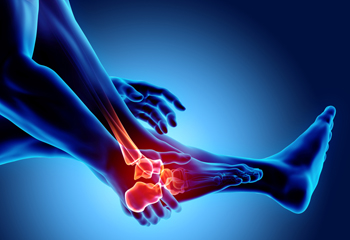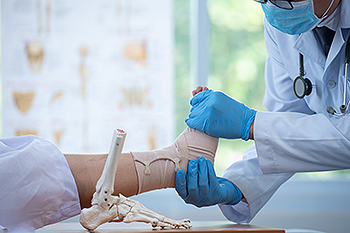Items filtered by date: October 2022
Grades of Ankle Sprains

When an individual sprains their ankle, they typically move or turn it in an unnatural way that ends up stretching ligaments in the ankle area. As a result, an individual might experience swelling and a diminished ability to move the ankle. There are several different types or grades of ankle sprains that you should be familiar with. First, there is the Grade I ankle sprain, which is defined as having relatively minor symptoms, such as a small degree of swelling. There are also Grade II ankle sprains, which are defined as having moderate symptoms. Those with Grade II symptoms might demonstrate a degree of instability and some moderate pain during physical activities. Lastly, there are Grade III ankle sprains, which are severe. This kind of injury can involve a large amount of swelling and a total rupture. If you have sprained your ankle, schedule an appointment with a podiatrist today who can treat your condition.
Ankle sprains are common but need immediate attention. If you need your feet checked, contact Donald Manger, DPM from Associated Podiatric Physicians, PA. Our doctor can provide the care you need to keep you pain-free and on your feet.
How Does an Ankle Sprain Occur?
Ankle sprains take place when the ligaments in your ankle are torn or stretched beyond their limits. There are multiple ways that the ankle can become injured, including twisting or rolling over onto your ankle, putting undue stress on it, or causing trauma to the ankle itself.
What Are the Symptoms?
- Mild to moderate bruising
- Limited mobility
- Swelling
- Discoloration of the skin (depending on severity)
Preventing a Sprain
- Wearing appropriate shoes for the occasion
- Stretching before exercises and sports
- Knowing your limits
Treatment of a Sprain
Treatment of a sprain depends on the severity. Many times, people are told to rest and remain off their feet completely, while others are given an air cast. If the sprain is very severe, surgery may be required.
If you have suffered an ankle sprain previously, you may want to consider additional support such as a brace and regular exercises to strengthen the ankle.
If you have any questions please feel free to contact our office located in Hamilton Township, NJ . We offer the newest diagnostic and treatment technologies for all your foot and ankle needs.
Gout Pain Can Be Managed
How Arthritis Can Affect the Feet and Ankles

Many types of arthritis can affect the small joints of the feet, ankles, and toes. These include osteoarthritis (OA) and rheumatoid arthritis (RA). OA is thought to be a wear and tear disease because it causes the cartilage in the joints to wear down from repeated stress over time. The bones lose their protective coverings and start to rub together leading to inflammation and pain. This type of arthritis mainly affects the first metatarsal joint (MTP), which connects the big toe to the foot. It can also impact the midfoot and ankle. RA is an autoimmune disease that involves multiple joints throughout the body. The immune system causes inflammation that attacks the synovium (lining of the joints) that cover joints and causes them to become swollen and painful. This type of arthritis often begins in the feet and ankles but can also affect the heels, midfoot, and forefoot. It is symmetrical, meaning it affects the same joints on both sides of the body. Repeated attacks can lead to bone, joint, ligament and tendon damage, eventually causing deformity or disability. Anyone with these or other types of arthritis can experience foot involvement and it can make it hard to walk and get through daily life. While there is no cure for arthritis, there are treatment options to slow down the progression of the disease and relieve symptoms. Please see a podiatrist for help if your arthritis is affecting your feet.
Arthritis can be a difficult condition to live with. If you are seeking treatment, contact Donald Manger, DPM from Associated Podiatric Physicians, PA. Our doctor can provide the care you need to keep you pain-free and on your feet.
Arthritic Foot Care
Arthritis is a joint disorder that involves the inflammation of different joints in your body, such as those in your feet. Arthritis is often caused by a degenerative joint disease and causes mild to severe pain in all affected areas. In addition to this, swelling and stiffness in the affected joints can also be a common symptom of arthritis.
In many cases, wearing ill-fitting shoes can worsen the effects and pain of arthritis. Wearing shoes that have a lower heel and extra room can help your feet feel more comfortable. In cases of rheumatoid arthritis, the arch in your foot may become problematic. Buying shoes with proper arch support that contour to your feet can help immensely.
Alleviating Arthritic Pain
- Exercises that stretch the foot can prevent further pain and injury and increase mobility
- Most of the pain can be alleviated with anti-inflammatory drugs, heat, and topical medications
- Massages can help temporarily alleviate pain.
It is best to see your doctor for the treatment that is right for your needs and symptoms. Conditions vary, and a podiatrist can help you determine the right method of care for your feet.
If you have any questions, please feel free to contact our office located in Hamilton Township, NJ . We offer the newest diagnostic tools and technology to treat your foot and ankle needs.
The Pain in Your Feet May Indicate Rheumatoid Arthritis

The signs of rheumatoid arthritis are often first noticed in the feet. It is considered to be a type of inflammatory arthritis and can cause severe pain and discomfort. Common symptoms associated with this condition include swelling, and the foot may feel warm and sore when touched. The foot also may gradually change shape, and this may lead to joint instability. Most people who are afflicted with this ailment notice that the smaller joints of the toes are affected. It is often challenging to walk, and it may be difficult to complete daily activities. In severe cases, the joints can rub together excessively, possibly affecting bursae. These are defined as sacs that are filled with fluid and may become inflamed, which is known as bursitis. If you notice the beginning signs of rheumatoid arthritis in your feet, it is strongly advised that you schedule an appointment with a podiatrist as quickly as possible who can properly evaluate and treat this condition.
Because RA affects more than just your joints, including the joints in your feet and ankles, it is important to seek early diagnosis from your podiatrist if you feel like the pain in your feet might be caused by RA. For more information, contact Donald Manger, DPM of Associated Podiatric Physicians, PA. Our doctor will assist you with all of your podiatric concerns.
What Is Rheumatoid Arthritis?
Rheumatoid Arthritis (RA) is an autoimmune disorder in which the body’s own immune system attacks the membranes surrounding the joints. Inflammation of the lining and eventually the destruction of the joint’s cartilage and bone occur, causing severe pain and immobility.
Rheumatoid Arthritis of the Feet
Although RA usually attacks multiple bones and joints throughout the entire body, almost 90 percent of cases result in pain in the foot or ankle area.
Symptoms
- Swelling and pain in the feet
- Stiffness in the feet
- Pain on the ball or sole of feet
- Joint shift and deformation
Diagnosis
Quick diagnosis of RA in the feet is important so that the podiatrist can treat the area effectively. Your doctor will ask you about your medical history, occupation, and lifestyle to determine the origin of the condition. Rheumatoid Factor tests help to determine if someone is affected by the disease.
If you have any questions please feel free to contact our office located in Hamilton Township, NJ . We offer the newest diagnostic and treatment technologies for all your foot and ankle needs.
A Broken Foot and a Sprained Ankle May Share the Same Symptoms

A broken foot often requires immediate medical attention. It generally causes severe pain and discomfort and can happen for a variety of reasons. These include a foot injury, twisting it well beyond its normal range of motion, or an accident. Symptoms include swelling, bruising, and difficulty bearing weight. If the foot is severely fractured, a bone may protrude from the skin, appearing to be displaced. A mildly broken foot may be confused with a sprain, because the two types of injuries share similar symptoms. Some patients hear a popping sound, which is often indicative of a broken foot, rather than a sprained ankle. A proper diagnosis can confirm a broken foot by having an X-ray taken. Treatment can begin by having a cast put on the affected foot, which is helpful in providing stability as the healing process occurs. Crutches are often recommended to use while the foot is in a cast, helping the patient to remain mobile. If you have broken your foot, please call a podiatrist’s office as quickly as possible for proper treatment techniques.
A broken foot requires immediate medical attention and treatment. If you need your feet checked, contact Donald Manger, DPM from Associated Podiatric Physicians, PA. Our doctor can provide the care you need to keep you pain-free and on your feet.
Broken Foot Causes, Symptoms, and Treatment
A broken foot is caused by one of the bones in the foot typically breaking when bended, crushed, or stretched beyond its natural capabilities. Usually the location of the fracture indicates how the break occurred, whether it was through an object, fall, or any other type of injury.
Common Symptoms of Broken Feet:
- Bruising
- Pain
- Redness
- Swelling
- Blue in color
- Numbness
- Cold
- Misshapen
- Cuts
- Deformities
Those that suspect they have a broken foot shoot seek urgent medical attention where a medical professional could diagnose the severity.
Treatment for broken bones varies depending on the cause, severity and location. Some will require the use of splints, casts or crutches while others could even involve surgery to repair the broken bones. Personal care includes the use of ice and keeping the foot stabilized and elevated.
If you have any questions please feel free to contact our office located in Hamilton Township, NJ . We offer the newest diagnostic and treatment technologies for all your foot and ankle needs.

